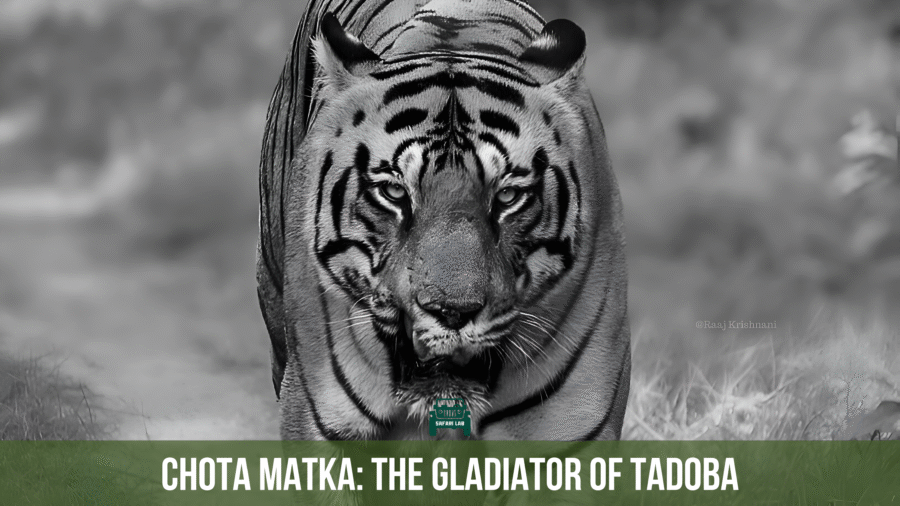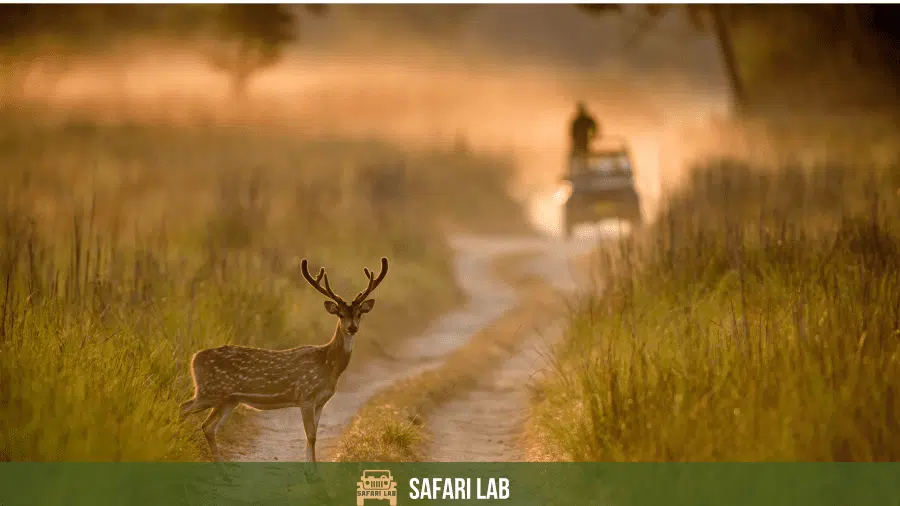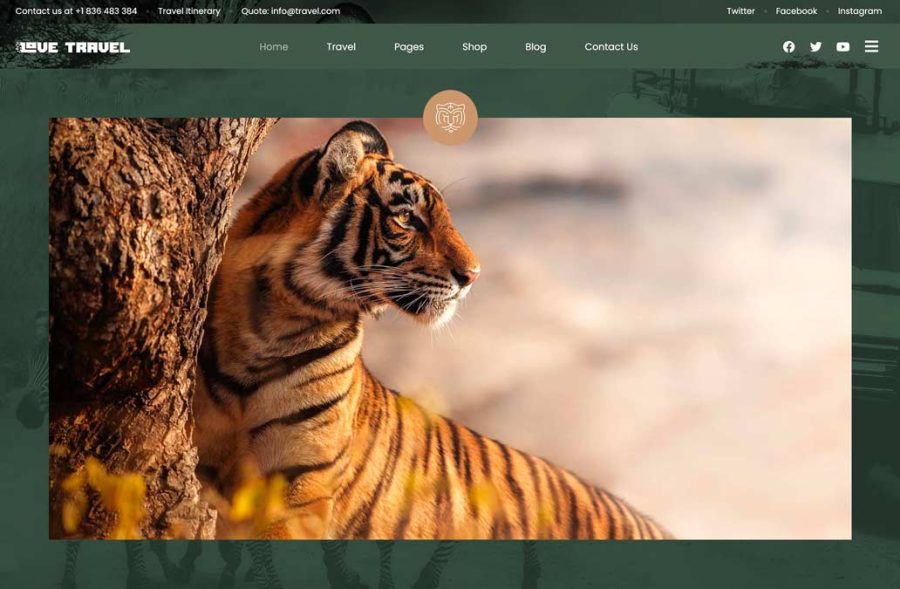Lets start this narrative about Chota Matka with the most recent event that cements his position as the uncrowned king of Tadoba. Its May 2025. Dusk descends over the Nimdhela-Navegaon zone, its fading light spilling across Umrikhora like embers over ash.
In this silent corner of Tadoba, near the ancient ruins of Ramdegi, tension coils through the forest like a drawn bow. For weeks, the jungle had whispered of conflict—pugmarks intercepted, scent trails overwritten, and the warning coughs of chital echoing louder than usual.
Two ambitious young males, Brahma and Veerabhadra, had been probing this contested stretch of bamboo and teak, testing the strength of an empire ruled by a single, storied monarch. Then, as the golden hour wanes, he arrives. Chhota Matka.
Older now, thicker around the shoulders, bearing the slow grace of a beast who has seen too many summers and survived every one.
His blue eyes, clouded by dust and experience, sweep the clearing. No hesitation. No theatrics. When Brahma charges, he answers—not with fury, but with finality.
The forest explodes into chaos. And when stillness returns the next day, one body lies broken among the bushes close by. That of Brahma, the young challenger. The other, scarred and sovereign, limps slowly, relying on time to heal the deep wounds of a battle anew.
Chhota Matka has defended his crown once more—against youth, against time, against the dying light itself.
Chota Matka Early Life: Born of Blood and Bamboo
Chota Matka was born in the monsoon of 2016, deep within the cradle of Tadoba’s core zone. His mother, Choti Tara, was a tigress known as much for her gentleness as for her nerve—calm in stride, fierce in defence.
His father, Matkasur, in contrast, was an empire-builder: wide-chested, territorial, and unchallenged for years across Tadoba’s central range. Together, they brought forth a lineage that was bound for both greatness and grief.
Among the litter was Tara Chand, a sibling remembered only in silence. In 2018, still young and unformed, he met a tragic end—electrocuted by an illegal power line, a reminder that the dangers of the forest extend beyond claw and fang.
His absence would leave a hollow in the jungle’s narrative, and perhaps, shape the lone survivor more deeply than any battle ever could.
As a cub, Chota Matka was curious, cautious, always close to his mother’s flank. Choti Tara taught with patience—how to stalk through ankle-high grass, how to read the wind, how to vanish when the jungle turned hostile.
Matkasur’s visits were rarer but thunderous; his presence stirred even the ground. And somewhere between the two, the young cub learned both silence and strength.
Chota Matka’s Young Days: Life Before the Claws
For a young tiger, the jungle is not yet a kingdom—it is a labyrinth. The life between weaning and war is marked by shadow-learning, mimicry, and moments of false courage. Chota Matka, like all subadults, walked the blurred line between protection and peril. His mother was still near, but each day she pulled back a little more, urging him toward self-reliance.
These are the hidden years—the forest’s quiet apprenticeship. A young tiger learns the scent trails of sloth bears, the gait of nilgai, the arc of a langur’s alarm call. Every bush could house danger. Every silence could swell into a roar. For Chota Matka, the lessons came layered. A failed stalk, a slip on wet stone, a missed leap—each moment trimmed the edges of his instincts.
He grew lean, then muscular. His gait thickened into something purposeful. The boyishness left his eyes. But he was still not a ruler. Not yet. The jungle doesn’t crown its kings—it tests them, tears at them, marks them. And Chota Matka’s first mark came not from a rival, but from an ambush that few tigers survive.
The First Wound: Baptism by Boar
It was October 2017, the air still thick with post-monsoon damp, the undergrowth dense and humming with life. Somewhere near the riverine belt beyond Tadoba Lake, Chota Matka—still a lanky subadult, muscles forming but untested—made his move. A wild boar, snorting and rooting near the edge of a waterhole, seemed a worthy first challenge. Not easy prey, but neither impossible. He crouched. Waited. Launched.
But wild boars are no passive quarry. The tusker turned, slashing upward with brutal force. In a single moment, the hunt reversed. A tusk tore into Chota Matka’s right abdominal flank—deep, jagged, and bleeding. He limped away into the grass, his body trembling, his pride shredded by pain. The jungle swallowed him whole.
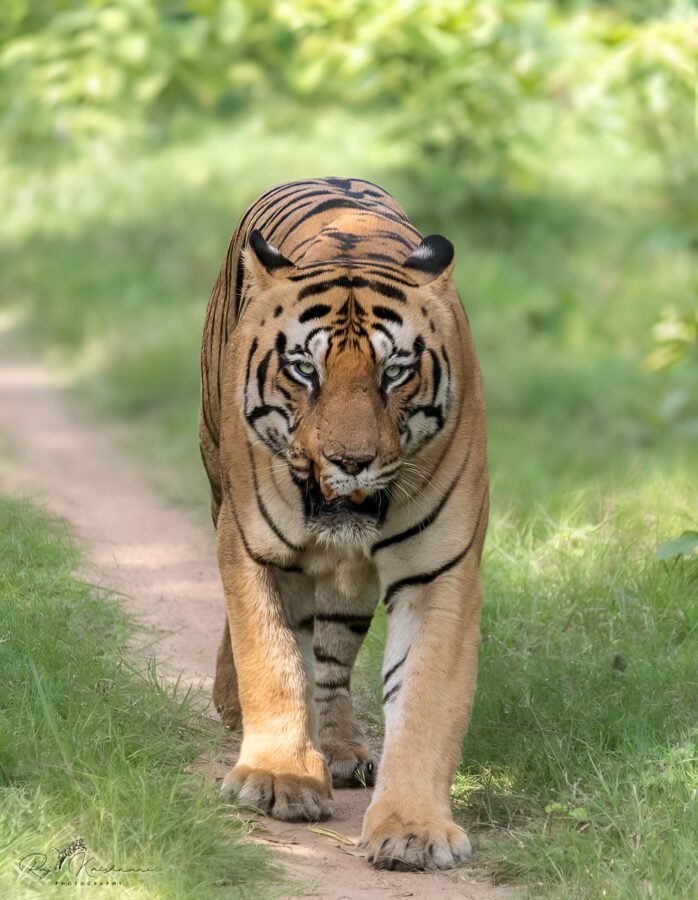
Image Courtesy: Raaj Krishnani
For days, there were no sightings. Only bloodied pugmarks. Then, one morning, Choti Tara appeared beside him. Forest officials watched quietly, keeping their distance, knowing the healing would come not from medicine but from time, silence, and a mother’s vigilance. She stayed with him, brought him kills, cleaned the wound the way only a wild mother could—with patient licks and proximity.
The scar never fully faded. Even now, older and wider, it can be seen—a rugged reminder etched into muscle. But more than skin was torn that day. Something in him shifted. Pain, real and close, became familiar. And with it came a slower, sharper instinct. From that wound, Chota Matka emerged no longer a cub in training—but a tiger who had felt death brush past.
The Turning Point: The Mowgli Conflict
By 2021, Chota Matka had grown into his name—not small anymore, but not yet a monarch. He was a powerful adult, muscular and broad across the shoulders, but his territory was undefined, floating. He skirted the boundaries of larger males, patrolled buffer zones, waited. The jungle was watching. So was Mowgli.
Mowgli was no mere rival. A robust male with a powerful frame and an aggressive edge, he held ground near the Panderpauni meadows—prime territory laced with water sources, prey trails, and forest cover.
When Chota Matka made his first attempt to challenge him, the outcome was brutal. In the clash that followed, Mowgli tore into him with a fury that left him disfigured—an ear tattered, his shoulder bloodied, pride bruised deeper than the skin.
But Chota Matka did not vanish. He withdrew. Waited. Watched.
Over the next few months, his presence became ghostlike—pugmarks reappeared where they shouldn’t. Scent sprays over Mowgli’s. Silent defiance, not open war. And when the moment came again, it was swift. A second fight, this time under the cover of tall grasses and near-silent alarm calls. Mowgli, taken off guard, fought desperately—but the balance had shifted.
Chota Matka, hardened by his earlier loss and years of roaming, overpowered him with precision. The defeated male slunk out of the area, never to reclaim it.
From that moment, the jungle knew: Chota Matka had arrived.
He did not waste time. With Panderpauni and its surrounding sectors under his control, he began what many tigers never get to do—he sowed legacy. He mated with tigresses like Jharni, Babli, and Bhanushkindi, each encounter followed, months later, by the soft-footed signs of new life. Cubs emerged in dens tucked between rocks and ghost trees, bearing his quiet strength in their eyes.
No longer a wanderer. No longer a contender. Chota Matka was now a father—and a king.
The Legacy of a King: Chota Matka’s Cubs
Following his triumph over Mowgli, Chota Matka solidified his reign over Tadoba’s buffer zones, particularly the regions of Nimdhela, Alizanza, and Navegaon. With dominance established, he turned to perpetuating his lineage, mating with several tigresses and siring multiple litters.
Jharni’s Offspring
Tigress Jharni, known for her resilience, bore Chota Matka’s cubs after his ascension. Previously, her cubs fathered by Mowgli were lost during territorial upheavals. With Chota Matka, she successfully raised a new litter, observed thriving in the core zones, showcasing the genetic vigor of their sire.
Babli and Kalua
In the Alizanza region, tigress Babli mothered cubs with Chota Matka. Among them, a male cub named Kalua gained attention for his bold demeanor and hunting prowess, traits reminiscent of his father. Kalua’s transition into independence marks the continuation of Chota Matka’s formidable lineage.
Bhanushkindi’s Trio
The elusive tigress Bhanushkindi, primarily inhabiting the Nimdhela buffer, also mated with Chota Matka. She raised three cubs—two males and a female—who have become prominent figures in the buffer zones. These sub-adults, now nearing independence, are frequently sighted and have been named Shiva, Hajare, and Nayantara by local guides.
Chandani: The Rising Star
Among Chota Matka’s offspring, Chandani stands out. Born to tigress Jharni, Chandani has exhibited remarkable independence from a young age. She separated from her mother before turning two and began establishing her own territory in the Navegaon zone.
Her boldness and adaptability have made her a candidate for translocation to the Similipal Tiger Reserve, aiming to bolster tiger populations there.
Chota Matka’s role as a progenitor has not only ensured the continuation of his bloodline but also contributed to the genetic diversity and stability of Tadoba’s tiger population. His cubs, embodying his strength and resilience, stand as living testaments to his enduring legacy.
The Bajrang Confrontation: The King has Arrived
By November 2023, the forests around Chimur whispered of change. In Wahangaon hamlet, where the bamboo thickens and light falls in slits, something stirred—something older, heavier than the usual rustle of langurs or the distant call of peacocks. Two legends had crossed into the same map. One, ascending. The other, fading but formidable. Chota Matka. And Bajrang.
Bajrang was no ordinary tiger. He was forest memory itself—an ageing monarch with a prodigious legacy, having fathered close to fifty cubs with tigresses across Navegaon, Kolsa, and the Chimur buffer. His blood ran thick through Tadoba’s veins. For years, he had ruled vast territories with effortless menace, his gait alone enough to silence alarm calls. But age was catching up, and so were challengers.
Chota Matka, now in his physical prime, had begun extending his reach into this area—drawn not just by prey and water, but by instinct. A land so fertile, once ruled by such a sire, could not be ignored. Bajrang likely sensed it too. He didn’t retreat.
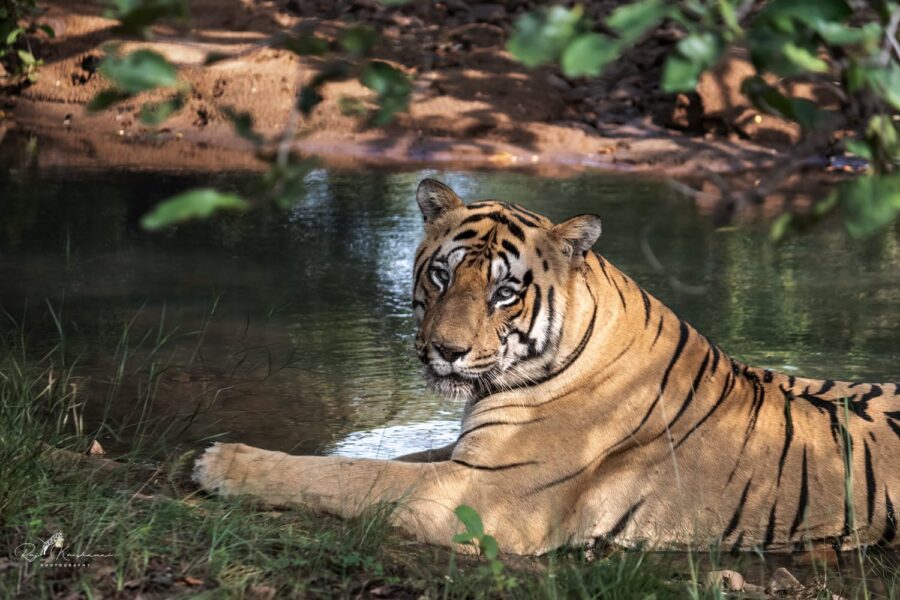
Image Courtesy: Raaj krishnani
The fight unfolded near Wahangaon, hidden from tourists but not from forest patrols who later traced the aftermath—deep drag marks, tufts of fur, claw scores on teak. Locals recalled an eerie night: barking deer that didn’t stop, and dogs howling at the wind. In the clash that followed, the two giants met not as strangers, but as embodiments of legacy.
Bajrang fought like a cornered emperor, relying on precision honed by years of battle. But Chota Matka had youth, mass, and rhythm on his side. The outcome was brutal. When dawn broke, Bajrang was found lifeless in a shallow depression, still facing the direction he had charged. The forest had not taken him quietly. But it had taken him.
And with that, a dynasty closed.
Chota Matka did not roar. He never did. He simply walked the perimeter, now his, as if it had always been. There were no more tigers left to challenge. But the jungle had grown quieter—not in fear, but in reverence. A page had turned, written not in ink, but in blood, dust, and the unbroken rhythm of survival.
The Brahma Clash: Holding the Throne
Coming back to where we started from, the summer of May 2025. The forest was already restless. Tadoba had entered the first blistering phase of summer, the underbrush crisp, the air dry and metallic. At Umrikhora—an undulating mosaic of bamboo groves and open grassland near Ramdegi—the heat was not the only thing rising. Two young males, Brahma and Veerabhadra, had begun pushing hard into Chota Matka’s eastern territory.
This wasn’t mere boundary testing. These were coordinated incursions, perhaps even cooperative. Such tactics, rare among solitary tigers, had been whispered about by local guides. One would scent-mark while the other followed a day later. They shadowed him. Watched him from the thickets. Tension built for weeks, a quiet war waged with scent and stealth.
Then it snapped.
Late one evening, during a safari round in the Nimdhela-Navegaon zone, the jungle erupted near Umrikhora. A flash of movement. A roar so deep it shook the bushes. What unfolded next wasn’t a duel.
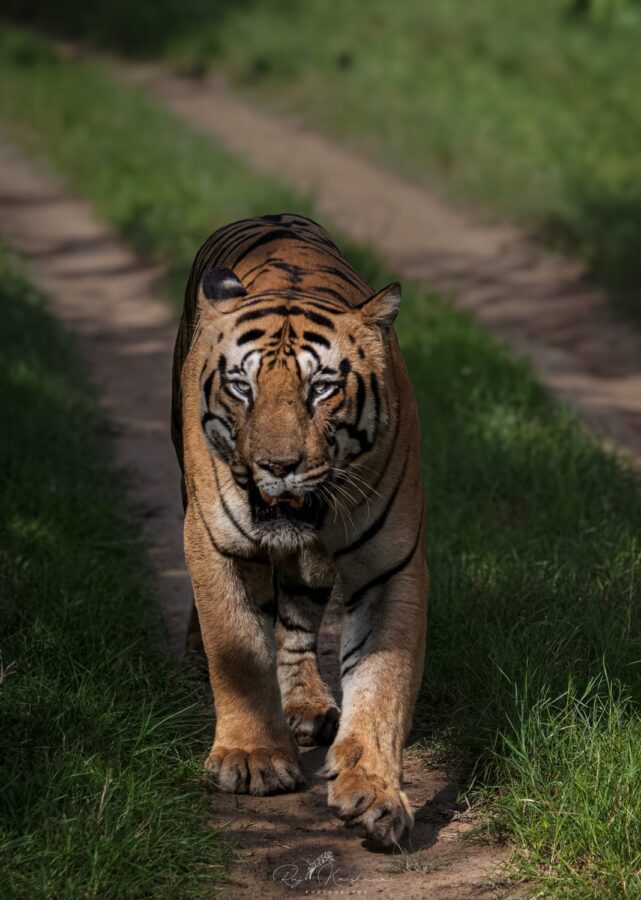
Image Courtesy: Raaj Krishnani
It was a storm. Brahma led the charge—young, fast, reckless. But Chota Matka was ready. Even at his age, with fading speed and a torso marked by old battles, he fought like a tactician. He knew how to position, how to bait, how to outlast.
The clash was short. Brutal. Final.
When the dust cleared and forest officials later surveyed the site, Brahma’s body was found among crushed bamboo. Veerabhadra had vanished, slipping away into the thickets under cover of panic. Chota Matka, bloodied but upright, was seen limping toward a shaded stream. Not retreating—just recalibrating.
What he’d defended wasn’t just turf. It was memory. It was the right to still be counted among the living legends of Tadoba.
This fight marked a turning point, not just for him, but for the forest.
Few tigers at his age still fight, let alone win. His endurance—his ability to read, wait, strike—placed him among the greats. Those who do not rule through brute force alone, but through the weight of their presence.
Chota Matka: Frequently Asked Questions (FAQ)
Where can I spot Chota Matka now?
As of 2025, Chota Matka is most frequently sighted in the Nimdhela-Navegaon buffer zones of Tadoba-Andhari Tiger Reserve. Safari sightings tend to increase during evening rounds, especially in the dry season when tigers move toward water sources.
How old is Chota Matka now?
Chota Matka was born in 2016, making him 9 years old in 2025. This is considered the late prime for a male tiger—when power and experience are at their peak, but threats from younger males become more frequent.
What makes Chota Matka so popular among tourists and photographers?
Several factors contribute to his popularity:
- Striking appearance: He has distinctive blue eyes and prominent battle scars, not to mention the massive frame.
- Visibility: He is frequently seen during safaris, especially in accessible buffer zones.
- Dramatic life story: His journey from an injured cub to a dominant male has captivated many. Each sighting carries a sense of narrative weight.
How many cubs has he fathered?
Chota Matka has sired multiple litters with tigresses including:
- Jharni, mother of Chandani
- Babli, mother of Kalua
- Bhanushkindi, mother of Shiva, Hajare, and Nayantara
Though exact numbers vary, he is regarded as one of the most successful breeding males in Tadoba in recent years, second only to legendary tigers like Bajrang.
What is his current health status?
Following a confrontation with Brahma in May 2025, Chota Matka sustained minor injuries but remains active and healthy. His movement patterns are consistent, and no serious health concerns have been observed by field staff or trackers. He continues to patrol his core and buffer territories regularly.
What zones should I book for a higher chance to see him?
Your best chance to spot him is in:
- Nimdhela Buffer Zone (especially Umrikhora)
- Navegaon Zone
- Chimur and Alizanza ranges, particularly near known water sources and scent-marked trails.
What time of year is best to see Chota Matka?
- Summer (April to June): Ideal visibility as water becomes scarce and tiger movement is concentrated.
- Post-monsoon (October to November): Good for sightings in denser greenery, though tracking becomes more difficult due to foliage.
How does he behave around vehicles or humans?
Chota Matka is calm and composed around safari vehicles. His tolerance suggests years of exposure to tourists and photographers. He neither avoids nor charges at jeeps, making him a reliable subject for wildlife watchers.
What’s next for Chota Matka?
Although he remains dominant in key buffer zones, younger males like Veerabhadra are becoming bolder. Whether Chota Matka continues to rule or makes way for a successor will likely be decided within the next couple of years. His legacy, however, is already deeply rooted in the landscape of Tadoba.
Conclusion: The King in the Bamboo
In Tadoba, time moves with the rhythm of paws on dust. Seasons turn, cubs grow bold, and territories shift like mist—but some names do not fade. Chota Matka is no longer just a tiger. He is an inheritance. His body bears the cartography of conflict: each scar a border, each limp a legacy. He has outlived brothers, outlasted challengers, and fathered the next wave of striped shadows that will haunt this forest long after he is gone.
But his story is more than just dominance. It is resilience in a fractured wild, strategy in a landscape that remembers every step. From the pain of a boar’s tusk to the silence that followed Bajrang’s fall, he has moved through Tadoba not just as a predator—but as a presence.
For those who wait quietly on a dusty trail near Ramdegi, a glimpse of Chota Matka is not just a sighting. It is an encounter with the jungle’s memory—alive, alert, and watching.
And when he is gone, the wind will carry his story through the bamboo. Not in roars, but in whispers. Because some kings don’t need a throne to rule—only a forest that remembers.

